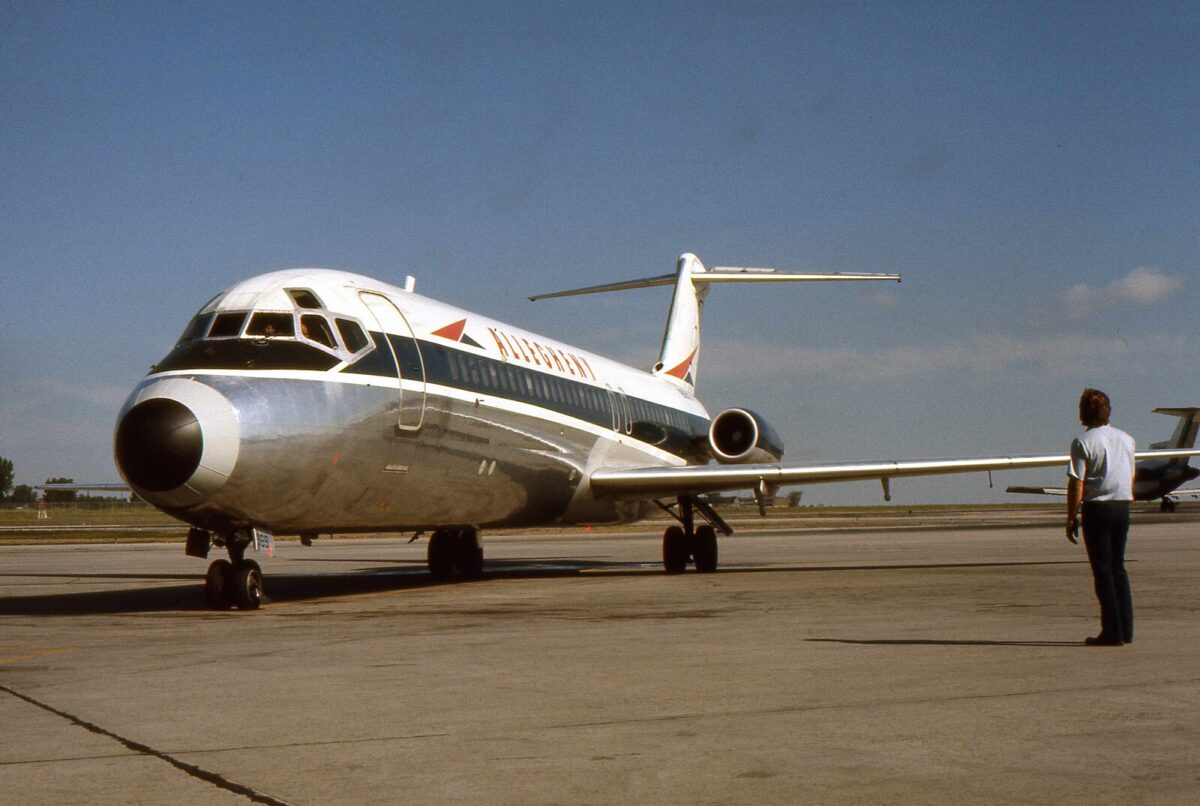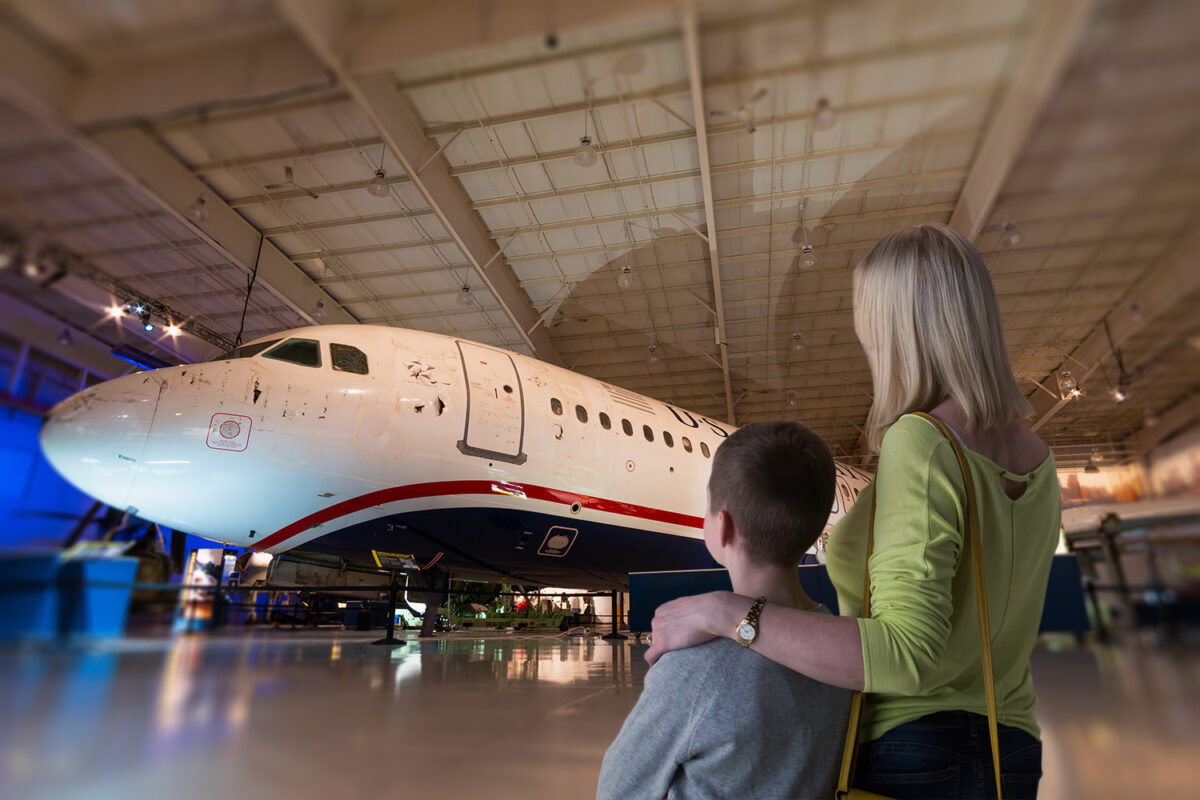Once a powerhouse of American aviation, US Airways was a notable success story of the 20th century. What started as a small airmail service evolved into a major airline, expanding across the US and beyond. But despite its success, the brand ultimately disappeared—so what happened?
From pioneering codeshare agreements to surviving bankruptcies and mergers, US Airways had a colorful history. The dream finally ended in 2015 when its merger with American Airlines saw the brand dropped for good. Nevertheless, its influence on modern aviation is far from forgotten.
A brief history of US Airways
US Airways’ history stretches right back to 1937, when a company by the name of All American Aviation was founded in Pennsylvania. Commencing operations in 1939, the company used small aircraft like the Stinson Reliant to deliver mail throughout the Ohio River valley.
In the late 1940s, the airline switched from airmail to passenger service, rebranding as All American Airways in the process. In 1953, the airline rebranded again, this time to Allegheny Airlines, a name that would stay in place for 26 years.
In order to run passenger services across Pennsylvania, Allegheny invested in turbine airliners including the Convair 540, Fairchild F-27 and DC-3. In 1965, it received its first jet – a Douglas DC-9-10, which was later followed by Boeing 727s, DC-9-30s and DC-9-50s.

As Allegheny grew, it began soaking up smaller airlines. Lake Central Airlines was absorbed in 1968, then Mohawk Airlines in 1972, making Allegheny one of the largest airlines in the northeast US.
Even in these early days, this former incarnation of US Airways was breaking boundaries. Allegheny formed an agreement with Henson Airlines, a predecessor to Piedmont Airlines, which is considered to be the industry’s first codeshare agreement.
When deregulation came about, Allegheny changed its name to USAir to reflect its greater reach. It was the launch customer for the Boeing 737, which allowed the airline to expand into the south of the States.
It changed its name to US Airways in 1997, introducing a new, fresh corporate identity. By the turn of the millennium, it was operating widebodies to Europe and was one of the biggest airlines in the US. It had established a low-cost carrier, ‘MetroJet’, and had bought the remains of Trump Shuttle for further expansion.
But with the new millennium came new problems.
Why did US Airways shut down?
Contrary to popular belief, US Airways did not shut down as such. Although it was suffering financially, it took the proactive step of consolidating with another airline, which ultimately saw its name and brand retired. Nevertheless, the post-millennial years were not kind to US Airways.
The September 2001 terrorist attacks massively disrupted all airlines, but as the largest carrier at Washington National Airport, US Airways was disproportionately affected by its extended closure. The resulting financial impact saw it shut down its MetroJet subsidiary, furloughing thousands of employees.
US Airways entered bankruptcy on August 11, 2002, but managed to secure a government loan and was able to exit fairly quickly. However, things were still difficult, and in 2004, it entered Chapter 11 protection for the second time.
In 2005, the airline merged with America West. It was a complicated merger, with various holding companies and new entities created. Nominally, America West was the survivor, although the merged airline decided to retain the US Airways name and America West’s ‘CACTUS’ callsign.
Things were looking up for US Airways in its new merged form. The airline began upgrading inflight services and excitement surrounded the testing of a new seatback entertainment screen in 2008. But then the fuel crisis of that year hit, sending airline costs skyrocketing. US Airways was forced to roll back all of its upgrade plans before they even got started.
The airline was struggling to maintain its service and the cracks were beginning to show. It was ranked last in customer satisfaction in the annual American Customer Satisfaction Index by the University of Michigan in 2008, and things were about to get even worse.
On January 15, 2009, a US Airways Airbus A320 flew into a flock of geese as it was departing New York City’s LaGuardia airport. Both engines lost power, and it was only thanks to the prompt actions of Captain Chesley Sullenberger that all 150 passengers and five crew members made it out of the aircraft alive.
Beyond this, the airline had some pretty good years. It remained profitable and had no further incidents or accidents. It earned the top spot in the Airline Quality Rating report in 2011 and secured landing slots at London’s Heathrow Airport for a new service from Charlotte.
But to survive in the US during the 2010s, airlines had to become big. Really big. Delta had merged with Northwest in 2008, United merged with Continental in 2010, and Southwest acquired AirTran in 2011. To remain competitive, US Airways needed to grow even further.
Ultimately, US Airways bought American Airlines out of bankruptcy. The American Airlines brand was favored, which meant US Airways would disappear by 2015.
What planes did US Airways use?
At the time of its merger with American Airlines, the US Airways fleet looked as follows:
| Aircraft | Number in fleet | Number on order |
| A319 | 93 | |
| A320 | 60 | |
| A321 | 90 | 31 |
| A330 | 9 | |
| A350 | 22 | |
| Boeing 737-400 | 14 | |
| Boeing 757 | 24 | |
| Boeing 767 | 10 | |
| Embraer E190 | 20 |
All the aircraft, including the orders, were transferred to American Airlines. The A330s, 757s and E190s were all retired at the start of the pandemic in 2020. The 767s and old classic 737-400s never flew for American, and were retired in 2014. American airlines cancelled the order for the A350, electing to order more Boeing 787s instead.
The only part of the fleet still around today is the A320 family. It’s relatively easy to recognize the former US Airways aircraft by their registrations. If you find yourself on an American Airlines A320 family plane with a registration ending in UW or US, you can be pretty sure it’s a former US Airways aircraft.
If you’re really lucky, you’ll find an A320 family jet with a registration ending AW, e.g. N835AW, which is a nod back to the days of America West and likely an aircraft that has worn all three liveries.
Why was US Airways called Cactus?
The famous ‘CACTUS’ callsign was never actually US Airways’ designator. From 1979 until 2008, it used US AIR as its callsign, but when it merged with America West, the new airline retained CACTUS and dropped US AIR.
America West had been asked by the FAA to develop a unique callsign, after it was decided AMERICA WEST was too similar to AMERICAN and SOUTHWEST. It organized an employee contest to come up with a new designator, and CACTUS was the winner, beating other options including ROADRUNNER, FIREBIRD and PHOENIX.
Its home in the southwestern United States is synonymous with the giant Saguaro cacti, so the name fit well. When US Airways merged with America West, the merged airline kept the US Airways branding and name, but retained its CACTUS callsign.
Who bought out US Airways?
Although it wasn’t in the best financial shape, US Airways wasn’t actually bought out at all. Despite some misconceptions, US Airways in fact bought out American Airlines while it was in Chapter 11 bankruptcy. Ultimately, the US Airways name and brand would fade, but its DNA is still very much in the American Airlines we see today.
The first suitor was United Airlines. With US Airways in the same alliance as United, the merger would be easier, making it an attractive proposition. But despite extensive discussions during the early part of 2010, the deal wasn’t made, and United ultimately announced it would merge with Continental Airlines instead.
US Airways wasn’t the only airline in trouble in the early 2010s. AMR Corporation, parent company of American Airlines, filed for Chapter 11 bankruptcy protection in November 201l after losing more than $800 million in the first nine months of the year. Two months later, in January 2012, US Airways Group expressed an interest in taking over American Airlines.
After a year of discussions, the two airlines announced their plans to merge in February 2013. Despite attempts to block the merger, the companies overcame challenges and completed the merger on December 9, 2013.
The two airlines operated as separate brands for a short while, but on April 8, 2015, American Airlines operated the final flight with the ‘CACTUS’ callsign. On October 17, 2015, US Airways made its final flight, taking off from Philadelphia as US Airways Flight 1939. After stops in Charlotte and Phoenix, it landed in San Francisco as American Airlines Flight 1939, whereupon the US Airways brand and all operations were officially terminated.
How US Airways changed aviation
US Airways and its predecessors laid the groundwork for much of modern aviation as we know it. Some of the initiatives the airline pioneered include:
- Hub-and-spoke operations: The airline strategically established hubs at major airports, which served as central connecting points for passengers. It’s a tried and tested business model today, but US Airways was one of the first.
- Alliances: USAir’s expansion into Europe in the ‘90s saw it forming partnerships with Trump Shuttle and British Airways. Some Boeing 767s were even painted in BA livery but operated by USAir. It’s thought to be one of the first transatlantic alliances in the industry’s history.
- Codeshare: In 1967, US Airways predecessor Allegheny Airlines entered into an agreement with Henson Aviation which would become the USA’s first codeshare relationship.
- Bulk ordering: Right before the rebranding to US Airways, USAir placed an order for up to 400 Airbus A320 family aircraft, with 120 firm orders included. At the time, it was the largest bulk aircraft request in history. Today, orders for hundreds of planes are commonplace, including at American Airlines, which placed an order for 260 new aircraft in 2024.
While the US Airways (and America West) brand is long gone, it’s certainly not forgotten. The DNA of this legacy airline seeps through into many aspects of modern aviation, and it will be remembered fondly for decades to come.

